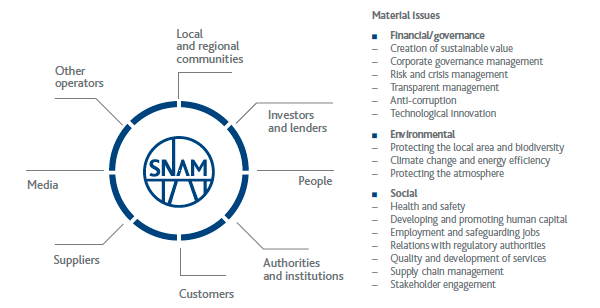Stakeholder relations and the capitals model
Shareholders, investors, the Authority and the gas system operators, employees, suppliers and all other corporate stakeholders have a central role in Snam’s business model.
In Snam’s business model, the stakeholders “interpret” the industry environment and can influence, sometimes decisively, the conditions that determine the availability of the different capitals that the business needs to be able to operate. These close ties with the capitals, which develop around material issues of mutual interest, enable the stakeholders to benefit from the value that the business creates through its activities.
Snam’s business is driven by the resources (financial capital), generated by its own operations and sourced on the market, that it transforms into the infrastructure (manufactured capital) and services required for the gas system to function using the decisive contribution of its human capital, comprising the people who work for the Company and the suppliers, with whom Snam, as an extended company, has very close ties. As such, the supply chain is an integral part of our business model and contributes to value creation by being directly involved in developing and maintaining the infrastructure network.
Our core activities are those that also have the most significant direct impacts (outcomes) in relation to workplace health and safety (accidents) and to the natural capital (use of energy and environmental resources).
In order to develop our business activities, internal cohesion, image and reputation are also important. As a result, it is essential to manage our long-term relations with stakeholders (social and relationship capital) by focusing on trust, listening, being universally open and transparent, and attempting to maintain and develop constructive dialogue both within and outside the Company.
The model also clearly shows how the business uses engagement to create value.
SNAM'S STAKEHOLDERS

More detailed information on the definition of material issues and how we engage with all stakeholders can be found in “Sustainable Paths – Report on social Responsibility”, which was published online at www.snam.it at the same time as the Annual Report.